by: Michael R. Lane
An historical recording, broadly defined, is any recording, of even limited interest, which is not currently available in the marketplace in its original format. This includes just about all recordings on cylinders, 78s, wire, tape, LPs, and broadcast transcriptions as well as many movie and TV soundtracks and private recordings. We use historical recording in a more limited sense to mean any recording of important content or performance which in sound quality does not adequately represent the performance. Dubbings or dubs are sometimes called transfers and are mechanically or electrically made copies of an original recording. Duplication of cylinders was originally done by mechanical dubbing, and the copies made were inferior to the original (as is the case with most electric dubs of 78s). However, the transfers of early vocal records done by the HMV (His Master's Voice) engineers in the 1940s are an excellent exception and show what could be done with care and effort. A repressing, as the name implies, is a new record stamped from an original metal part. If the metal part has not deteriorated from age or wear, the repressing can be superior to the original issue since modern vinyl takes a better impression and is much quieter than shellac. Reissue is a confusing term that can mean either repressing or dub.
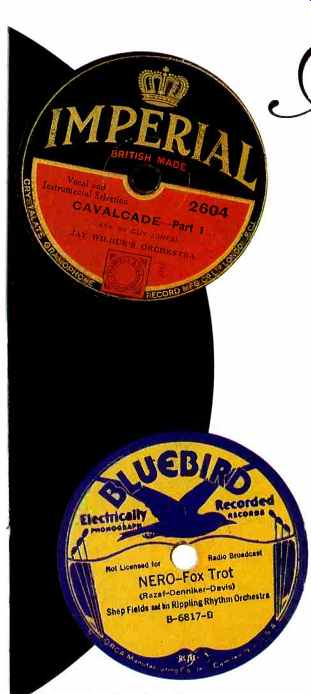
There are also three interrelated concepts in the field that are often confused with each other and need clarification. Sonic preservation is done by sound archives, universities, and others to preserve the sound of an original source, which may be deteriorating.
The main objective is to preserve the sound of original recorded media cylinder, record, tape, etc. The main considerations are long storage time and no alteration of the original sound (or at least none that can't be undone). The common method is two-track analog tape recording using modern low-print-through tapes, such as AGFA 468, and documenting everything that is done. including stylus size, turntable speed, and inherent playback equalization, if any. Some noise reduction, such as from the Packburn 323A noise suppressor, may be used, but nothing must be allowed to alter the sound of the source in any way. For the purist, the less done the better. Additionally, the original source will be treated with the greatest care possible, e.g., records kept in acid-free sleeves and stored at 65° F and 40% humidity.
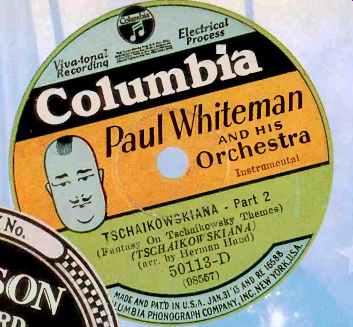
Sonic enhancement is the altering of a sound source to produce a desired result and may or may not accurately represent the sound of the original performance. Its criteria are subjective, usually commercial, and, more often than not, reflect the then-current popular ideas of what is good sound or will appeal to the buying public. Sonic restoration is similar to sonic enhancement in many of its techniques but more specific in its main objective, which is authenticity to the original performance. Authenticity is the central problem in sonic restoration, especially with acoustic material made before the development of the electrical re cording process in 1925, While the sound of acoustic (sometimes called mechanical) recordings gives some idea of what the original performance was like, the many technical limitations leave an incomplete and even false image of the artist. The same is true of early electrical recordings but to a much lesser extent; indeed, a false image is intentionally given on many modern recordings for "effect." The objective of the sonic restorer of historical recordings is to discover, or at least infer with some degree of objectivity, what the sound of the original performance was really like and then to make all modifications with this in mind. While all three-sonic preservation, enhancement, and restorationare interrelated and overlap to some extent, this discussion will be devoted primarily to sonic restoration.
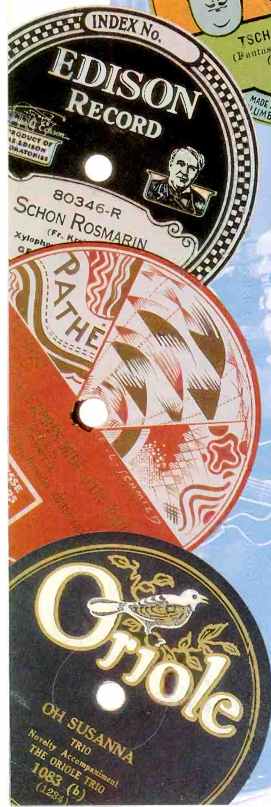
The sonic restoration of historical recordings is both art and science. The science can be analyzed, made objective, and taught, while the art is difficult to analyze, largely subjective, and probably unteachable. Although most of our discussion applies to all forms of historical recordings, from cylinders to LPs, we will be most concerned with 78s since they are the most common.
BASIC REQUIREMENTS
The condition of the sound source is of the greatest importance in restoration work. While current LPs and CDs may be uniform, 78s were pressed or engraved on different materials, including cement, rubber, wax, shellac, acetate, and vinyl, and they were made in different sizes, from about 3 to 20 inches in diameter. They first appeared in 1894, and by the late 1950s they were gone from the marketplace, except for a few repressings still being made today. The most common 78s are made of shellac or shellac compounds, and they suffer from dirt, warps, digs, or gouges; from being pressed off-center, and from aging, moisture damage, and all degrees of wear as well as cracks and outright breakage. Cleaning is mandatory and an extensive subject in itself. We have developed our own cleaning system, but if nothing better is available, a mild detergent, water, and a soft sponge generally work. Water can damage the base material on Edison Diamond Discs, and acetate recordings need special care and handling. Whatever method is used, after cleaning a record should be played once or twice using an extra-small stylus, as this will help remove embedded dirt and debris loosened from deep in the groove by the cleaning.
Many warps can be flattened between glass plates using carefully applied amounts of heat and pressure.
With off-center records, the center hole can be enlarged and the record carefully "re-centered" on the spinning turntable. Broken records, if the break is clean, can sometimes be glued or taped back together, with the tape on the reverse side. For bad gouges and digs, a temporary but useful technique is to fill in the damaged area using softened wax and to play the filled-in area of the record. before it becomes too firm, at a tracking force greater than normal. If the anti-skating force is perfectly balanced and the missing area is not too large. temporary groove walls will be formed that match up with the existing grooves. While not permanent, it is fast and usually enables the record to be played a few times for restoration. Extensive record repairs are only justified if the recording is very valuable or "one of a kind." With most common problem records undergoing restoration, the best solution is simply to find a better copy. Friendly collectors or sound archives may, if you promise to be very careful, loan you a good copy. Our own extensive collection of historical recordings has been of great assistance in this regard. Of course, with private recordings and rarities, the restorer has no choice but to work with whatever is available.
TURNTABLE SPEED AND PITCH
Many so-called 78s were not necessarily recorded at 78 rpm; they vary from the low 60s to over 100 rpm.
When some restorations and reissues are made, the source recording isn't played at the speed used when the original was made. and the result is a shift in pitch which destroys the integrity of the performance. To accurately adjust speed and the resulting pitch, a quality variable-speed turntable, equipped with a multi-speed strobe or digital speed readout, is essential, but the real problem is, how do you know what the speed of the source was so that you can duplicate it to get the correct pitch? Some guidelines are helpful. The older records are generally recorded at lower speeds. Victor acoustics are most often around 76 rpm, and their electrics prior to 1930 are also often at 76 or 77 rpm. Many European electric discs are at 80 rpm, with Pathés about 90 rpm. Edison Diamond Discs are quite consistent at 80 rpm. The earliest records tend to be at low speeds, with G & Ts (Gramophone & Typewriter discs) in the low 70s or even 60s.
One technique useful with records made using cutter tables and amplifiers using alternating current is to sync on the a.c. hum. If the current was at 60 Hz (50 Hz in Europe), and a sharply spiked filter is used to exaggerate the power-line hum frequency, along with an accurate digital counter for setting that current frequency, then by adjusting the turntable speed higher and lower, you can tune for maximum hum and hence the correct pitch of the original. It may also be possible to use the second harmonic of the alternating current. This approach doesn't always work, and with acoustic recordings that employ cutter tables driven by falling weights, it is impossible. Comparing the sound of a 78 with a modern recording of the same music can be a good reference to correct the pitch to A = 440, if A440 was the pitch in use when the original was made. Care with LPs is necessary. too, as not all such discs, that might be used for comparison are at exactly 33 1/3 rpm. A pitch pipe. electronic synthesizer, or properly tuned piano, in conjunction with the musical score, may serve as useful references. Singers on early 78s are the biggest problem because of common key transpositions, and here biographical and discographical information may provide keys the artist usually sang in and their favored transpositions. Some old records have a playback speed printed right on the label, but this, as well as listings of correct speed by "experts," should always be accepted with caution.
The actual frequency of concert A=440 Hz, has changed many times during the history of music, but at the time early historical recordings were made it was lower, about 435 Hz. Hence bringing everything to A =440 or the sometimes higher pitches found today does not do justice to many older recording artists because even a small shift, insufficient to make a tone really sharp or flat, will alter the timbre or quality of instruments and singers. The restorer should try to set the playback speed of cylinders and 78s to the exact speed used when the original was made. This will produce the correct pitch employed by the artist at the time of the performance, with no subtle alterations of the sound from changing to A=440. To correct pitch, the comparisons and hum technique indicated above are a starting point, but the musically trained and experienced ear, coupled with lots of experience with historical recordings, is still the best judge. The technique is to listen to the apparent "focus" of the sound, especially on vibrato. But despite all efforts, the correct pitch of some recordings will never be known with certainty.
CARTRIDGE AND STYLUS SIZE
A superb cartridge for 78s is the Shure V15 Type V used with their VN578E stylus assembly, but even better sound is obtained by using the VN578E assembly with Shure's Ultra 500 cartridge body. (See Table I for-equipment information ) I feel this combination is outstanding. Moving-coil cartridges, as opposed to the moving-magnet types, can offer somewhat better sound and, in particular, better transient response. However because a wide range of stylus sizes are necessary to play 78s properly, moving-coil cartridges are not suitable because frequent stylus interchange is difficult or impossible. The dynamic stabilizer brush integral to the Shure VN578E assemblies dramatically aids tracking of 78s with problem warps or broken-down groove walls. The elliptical stylus, mounted on the VN578E assembly (0.5 x 2.5 mils), is excellent for playing 78s of the 1940s and 1950s but not suitable for many earlier ones. Figure 1 gives our recommendations on stylus sizes; generally the earlier records take the larger sizes. Some believe that vertical-cut (hill and dale) records should only be played with conical styli. Old ideas die hard, but if common belief or theory says one thing and your ears say another, then throw out the theory and look for another that agrees with your ears! We know of no case where results are not improved by using elliptical styli. Furthermore, they should all be made in a truncated format (cut off on the bottom), as this minimizes noise pickup from the bottom of the groove. All styli should be diamond, but with the very large sizes necessary to play some vertical-cut records, cost may dictate the use of sapphire. The criterion on stylus selection for any given record is to choose the size that gives the cleanest, least distorted sound, not the least surface noise. Surface noise is much easier to deal with than distortion. Expert Stylus Co. can supply a wide variety of truncated elliptical styli mounted on Shure VN5781stylus assemblies, and their work is excellent.
TONEARM AND TRACKING
A high-quality tonearm long enough to play 16-inch transcriptions is a must.
Equally important is correct geometry.
Most tonearms come with specific mounting instructions detailing the turntable, tonearm, and cartridge geometry, but the proper approach is to
have correct turntable, tonearm, and stylus geometry-which can be quite a different thing. The overhang, azimuth, and lateral and vertical tracking angles must all be easily adjustable. They should be normally optimized for 12-inch LPs, but with problem records the adjustments may have to be altered to even make tracking possible. (Vertical tracking angle is now very common at 20° for LPs, whereas for 78s it is theoretically 0°.) For Pathé records, with their very shallow grooves, and for "center start" records, the ability to adjust anti-skating force can be crucial.
The optimization method for Pathés, and other apparently unplayable records, is to put the problem record on the turntable at its correct speed and then, with the stylus force reduced to almost nothing, gently lower the stylus to a position on the record about halfway through. The stylus will probably start skating across the record toward the inside or outside. Adjust the anti-skating force higher or lower until the stylus remains stationary without skating, then increase the tracking force to normal. This technique is not suitable for LPs and 78s that play normally, as it neglects the normal tracking pressure of the stylus, which is an important factor in normal anti-skating. However, we have found empirically that for problem trackers-the ones with shallow, deformed, slanted, or worn grooves-it is the way to go. To make the adjustment easily, the sliding-weight (not the weight-on-a-thread) type of anti-skating adjustment is best.
On some occasions with difficult trackers like Pathés, where you might expect to need a very large stylus, going to the exact opposite, a very small stylus, 1 1/2 or 2 mils, may solve tracking problems. With damaged records. you may need mechanical canting of the cartridge to make groove tracking even possible. This will require a tone-arm design whose headshell can be physically twisted. Playing a difficult tracker at half speed and recording it at 7 1/2 ips for later playback at 15 ips is another possibility. When all else fails, increase the tracking force but only as a last resort.
----------
TABLE I--Specific recommendations and sources of equipment. (Recommendations apply only to specific models or types.)
- Cartridge: Shure V15 Type V or Ultra 500; VN578E stylus assemblies
- 78-rpm Special Styli: Mounted on VN578E assemblies by Expert Stylus Co.
- Recording Cleaning Kit: Lane Audio & Records
- 60/100-rpm Analog Speed Strobe: Lane Audio & Records
- Digital Speed Readout: Jeffrey M. Duboff
- Turntables: Technics SP-15, Esoteric Sound Vintage and other custom models, and custom-built and/or modified models from Jeffrey M. Duboff
- Stylus/Tonearm/Turntable Geometry Kit: Lane Audio & Records
- Magnetic Cartridge Processor: Kinergetics KMP-1 (no longer made; company indicates they have several hundred incomplete units and might finish one at a premium price)
- Noise Suppressors: Packburn 323A; Dynafex DX-1 by Circuit Research Labs
- Inherent Record Equalizer: Esoteric Sound Re-Equalizer Multi-Graphic Equalizer: White Instruments 4650 (1/3 octave)
- Parametric Equalizer: Orban 642B parametric equalizer/notch filter
- Compression Limiting De-Esser: Orban 424A
- High-Frequency Enhancer: BBE Sound 442 sonic maximizer Analog Tape Recorders: Open reel, Otani MX series; cassette, Nakamichi MR-I Model B Analog Tape: Cassettes, TDK AR-X (Type I, C60) and MA-X (Type IV, C-60); open reel, Agfa 469 (mastering), Agfa 468 (low print), Ampex 456 (mastering), and Ampex 478 (low print)
- Contact Cleaner, Preservative: Cramolin R2 (2%) or R5 (5%) from Caig Laboratories
- Technical References: Handbook for Sound Engineers: The New Audio Cyclopedia edited by Glen Ballou (Howard W. Sams & Co., 1987). The Audio Cyclopedia, First Edition, edited by H. M. Tremaine (Howard W. Sams & Co., 1959; out of print.) Introduction to the Physics and Psychophysics of Music by Juan G. Roederer (Springer-Verlag, 1979; this basic textbook establishes the close relationship of physics, psychophysics, and neuropsychology to music). The Recording and Reproduction of Sound, Second Edition, by Oliver Read (Howard W. Sams & Co.; out of print). Audio Engineering Handbook edited by K. Blair Bensen (McGraw-Hill, 1988).
- New Repressings of Historical 78s on Vinyl: Vocal repressings from Historic Masters; instrumental, orchestral, and spoken repressings from Symposium Records
--------------
CARTRIDGE HOOKUPS
For best results in playing 78s, the cartridge should be connected in a normal stereo configuration and fed into a stereo preamp. Once the signal is amplified to line level, "canting control" can be used (Fig. 2). To make this control, a ganged audio-taper pot is wired so that the center point of rotation gives equal amounts of left-and right-channel output. This is far better than the traditional left-plus-right wiring for mono sound. since with this method any mixture is possible. Usually, equal .amounts of left and right signal are best, but sometimes noise and even distortion can be reduced by another mixture, possibly even all left or all right. For vertical-cut (hill and dale) records, a simple polarity-reversal, two-pole, double-throw toggle switch can be used in the cartridge leads of one channel to obtain the required vertical signal (Fig. 3). With proper shielding against noise pickup into low-level phono cables, this works adequately, but as in the case of the canting control, polarity reversal is better done at line level using an inverting op-amp to avoid grounding and shielding problems. The combination of canting and polarity reversal gives the ability to fine-tune any record for best sound and least noise.
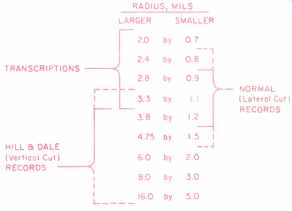
Fig. 1--Recommended stylus sizes for various types of old records. In general,
the older records take the larger styli.
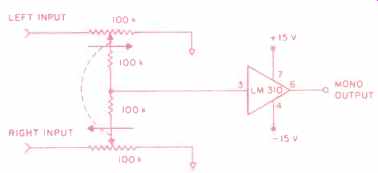
Fig.
2--It is better to blend line-level signals with this form of variable "canting
control" than to strap the cartridge's leads together for mono operation.
The ganged pots shown should have audio tapers.
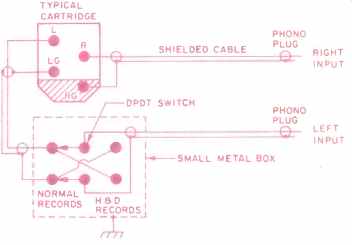
Fig. 3--For hill-and-dale recordings, you should wire a double pole, double-throw
switch into the output of the cartridge to reverse one channel's polarity before
mono summing. Wire the switch into the channel that is not grounded on the
cartridge, and shield it within a small metal box, grounded to the turntable
frame, and mounted close to the tonearm to keep leads as short as possible.
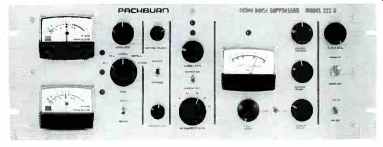
Fig. 4--The Packburn 323A noise suppressor has three systems designed to reduce
noise found on historical records.
EQUALIZATION
Considerable confusion exists about equalization, especially in reference to historical recordings. In its broadest sense, the term means altering the amplitude of one part of the audio spectrum in relation to another part. A level control should evenly increase or decrease the entire audio spectrum, while an equalizer increases or decreases only a part, sometimes a very narrow part. EQ, or equalization, is less confusing when it is thought of as being of two types-adjustable or inherent (original).
The simplest form of adjustable equalization, found on inexpensive radios, is the tone control, which merely decreases high frequencies and thereby gives the illusion of more bass. True bass and treble controls raise or lower bass and treble frequencies from a reference, such as 1,000 Hz. Another common type of adjustable equalizer is the simple low-pass (for scratch) or high-pass (for rumble) filter. For restoration work, scratch and rumble filters need to be more elaborate than those usually encountered on consumer equipment. We recommend a Butterworth design with switch selection for repeatability of settings. Our own filter set employs 12-position rotary switches. The low-pass positions are "Off" and 15, 12, 10, 8, 7, 6, 5, 4.5, 4, 3.5, and 3 kHz at a slope of 18 dB per octave; the high-pass positions are "Off" and 20, 30, 40, 50, 63, 80, 100, 125, 155, 190, and 230 Hz at a slope of 12 dB per octave. Building such a set of filters is not too difficult, and details can be found in many books on active-filter circuit design. The potentiometer-controlled type of filters has the advantage of being continuously variable, but with 12-position switch-selected filters, almost any desired setting can be found, and you have the advantage of exact repeatability.
The multi-graphic equalizer, now quite popular, divides the frequency spectrum into discrete frequency bands, each individually adjustable in gain. The term "graphic" refers to the position of the slide potentiometers, as they show peaks or dips in the sound spectrum as if they were plotted on a graph. (The simplest multi-graphics are five-band equalizers, with each band being two octaves wide. The one- and third-octave units are common in professional recording consoles, and even sixth-octave equalizers are becoming more common.) In sound work, as the number of bands increases, the multi-graphic equalizer becomes more complex to use. The one-octave (10-band) multi-graphic is a good choice for home systems, but for restoration work the half- or third-octave unit is preferred.
===========
ADDRESSES
- BBE Sound 5500 Bolsa Ave Huntington Beach, Cal. 92649
- Circuit Research Labs 2522 West Geneva Dr. Tempe, Ariz. 85282
- Caig Laboratories P.O. Box j Escondido, Cal. 92033
- Jeffrey M. Duboff P.O. Box 541 Andover, Mass. 01810
- Esoteric Sound 4813 Wallbank Ave. Downers Grove, Ill. 60515
- Expert Stylus P.O. Box No. 3 Ashtead, Surrey KT21 2QD, England
- Historic Masters 10 Yealand Dr. Lancaster LAI 4EW, England
- Kinergetics Research 6029 Reseda Blvd. Tarzana, Cal. 91356
- Lane Audio & Records 1782 Manor Dr. Vista, Cal. 92084
- Nakamichi 19701 S. Vermont Ave. Torrance, Cal. 90502
- Orban Associates 645 Bryant St. San Francisco, Cal. 94107
- Old Colony Sound Lab P.O. Box 243 Peterborough, N.H. 03458
- Otari 378 Vintage Park Dr. Foster City, Cal. 94404
- Packburn Electronics P.O. Box 335 DeWitt, N.Y. 13214
- Shure 222 Hartrey Ave. Evanston, Ill. 60204
- Symposium Records 110 Derwent Ave.
- East Barnet, Hertfordshire EN4 8LZ, England
- Technics One Panasonic Way Secaucus, N.J. 07094
- White Instruments 1514 Ed Bluestein Blvd. Austin, Tex. 78721
===========
Most versatile of all equalizers, the parametric is somewhat similar to the multi-graphic equalizer, in that it divides the audio spectrum into frequency bands and that the level or amplitude of each band can be separately controlled. Unlike the multi-graphics, where each band is fixed in frequency, the parametric can shift this band (within limits) higher or lower in frequency. In addition, the shape (broadness or narrowness, also known as Q) of the affected band can be controlled from very broad (several octaves) to very narrow (notch). These three variable parameters (level, frequency, and Q) give the parametric equalizer tremendous capabilities in dealing with difficult problems such as the resonances in acoustically made recordings. However, the very versatility of the parametric makes it difficult to use properly, since there is an almost infinite number of sonic combinations.
Eliminating one obvious problem can easily introduce another, more subtle one. The quasi-parametric, a type generally available on the consumer market, is not recommended because the three parameters are interacting, i.e., adjustment of any one affects the others. The true parametric, on the other hand, has non-interacting parameters and is easier to use, especially when trying to repeat a setting. We do not generally recommend the use of parametric equalizers by other than the most dedicated audiophile or sound-restoration buffs because of their complexity. Mere use of complex equipment does not guarantee good results.
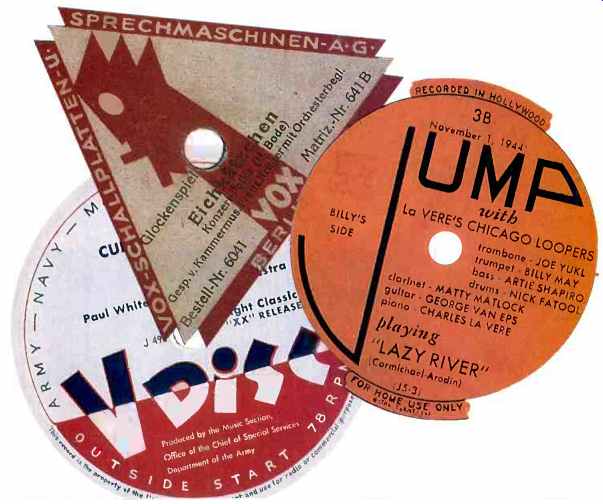
When used by inexperienced operators, the results are frequently exaggerated and unnatural. For those willing to spend the time and effort, the results with parametrics can be spectacular. We highly recommend the Orban Model 642B parametric equalizer/ notch filter. Particularly impressive are its clarity of sound and the high- and low-pass filters for scratch and rumble elimination. For many years we have used and been happy with Orban's Model 622, but the new 642B is a marked improvement.
The adjustable notch filter is a very useful type of specialized equalizer.
With its very narrow bandwidth and deep cut (40 or more dB), it can remove 60- or 120-cycle a.c. hum as well as cutter whistle, a problem on many early electric recordings, and do this without apparent effect on the overall sound. Notch filters can be distinct units, such as the UREI Little Dipper Model 565 (unfortunately no longer being manufactured), or as combined units as in the Orban 642B. A word of caution-filters that are very narrow (Q of 5 and over) with deep notches (40 dB and over) should be used with discretion, as they have very severe phase shift, which is inherent in their basic nature. Unless great care is taken, this can be audible. It should be a basic premise of restoration work that if the listener is aware of electronic processing, the restorer has made a mistake. These various adjustable sound-shaping equalizers are indispensable in working with 78s and many early LPs and may also be useful in undoing some excessive enhancement in modern recordings, especially pop.
Three of the most common media of sound communication for the music lover are FM radio, tape recordings, and phonograph records. Each of these has a type of inherent or original equalization. Part of the confusion in talking about equalization comes from not clearly distinguishing between this inherent EQ and adjustable or user EQ. In the creation of the FM signal, tape recording, or phonograph record, a "fixed" equalization is introduced; the physical and electrical nature of tape, records, and broadcast signal require this for best results. The playback equipment must reverse this process by introducing a fixed and opposite playback equalization. When everything is done correctly, the result is a more faithful reproduction of the original sound, with less distortion, greater dynamic range, and lower noise than would be possible if this inherent equalization were not used.
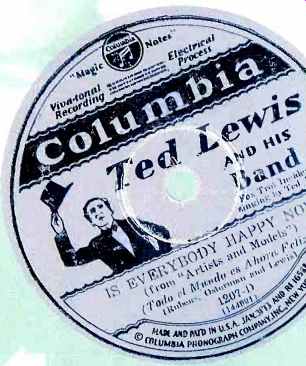
The inherent equalization of electric analog records consists of a treble boost and a bass cut when the record is made, and a corresponding treble cut and bass boost in the playback equipment. Just as open-reel tapes use the NAB (50-uS) standard equalization, and cassettes use the 70- or 120-µS standard EQ, so do records now have their own standard recording EQ curve-RIAA. (A slight variation is the IEC curve used mostly in Europe and the Far East.)
The acoustic records made before the development of the electrical process in 1925 were recorded mechanically, and inherent in that process is a theoretical constant-velocity response of the cutter. Since there was insufficient musical energy to overcome the mass of the linkage between horn and cutter, the result was not a true constant velocity output in the lower frequencies. We call the result inherent mechanical equalization. In the acoustic process, low frequencies, what there were of them, had large cutter excursions that decreased as frequency increased. With the development of the electrical process, with its greater frequency range, problems appeared.
The much lower frequencies could now be recorded but had too great a cutter excursion, and the greatly extended higher frequencies had such a small excursion that they were lost in the system noise. By changing from a constant velocity characteristic at some point in the frequency spectrum to a constant amplitude characteristic (which the electric process made possible), the problem could be solved, provided the playback machine did the same in reverse. The point in the frequency spectrum where the change takes place is the turnover frequency.
Additionally, it became possible to boost the higher frequencies when recording, and that, in turn, required a corresponding high-frequency cut or roll-off in playback. The result of all this was that it became possible to get extended high-frequency response, which wasn't lost in the surface noise, and extended low-frequency response, which didn't break across into adjacent record groove walls. The combination of turnover and roll-off characteristics became known as the recording or inherent equalization curve, and it took almost half a century before everything finally settled down into the international standard of the RIAA curve.
A big problem for the collector or sonic restorer of 78s and early LPs is the very great variety of recording equalization curves used by different companies from 1925 through the early 1950s. Many different curves were required by the playback equipment to inversely match the original recording curves, which changed from company to company, year to year, and in some cases day to day! Some of the older vacuum tube preamplifiers had four or five positions of playback equalization, but this wasn't really enough. One, the justly famous McIntosh C-8 vacuum tube preamp, had 10 slide switches, with all their multiple combinations, for controlling treble roll-off equalization and bass turnover equalization.
Hence, if you knew what the original recording equalization for a record was, then accurate playback equalization was possible. McIntosh also supplied an excellent chart that gave EQ settings for many different record companies. Some of the common terms for these differing playback equalization curves were NAB, Ortho, AES, ffrr, RIAA, Old 78, etc. In most modern audio systems for playing analog recordings, the playback equalization is now truly locked into the standard curve, and it is impossible with this equalization to play most 78s and many early LPs properly.
One approach to solving this problem is to use a multi-graphic equalizer to undo the gross distortions of the RIAA curve and simulate the various older equalization curves. It works after a fashion but takes considerable time and is definitely awkward. The Owl 1 monophonic preamp has a variety of EQ curves and is okay for a basic playback system, but we can't recommend it for serious work. The best approach is to use The Re-Equalizer by Esoteric Sound; it easily and accurately solves the equalization problem.
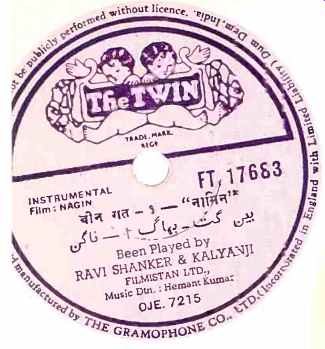
Connected at the output of a preamp with RIAA equalization, it can undo the RIAA curve and offers six positions of turnover and six positions of roll-off. Its 36 possible EQ combinations can duplicate almost any of the old curves that will be encountered.
=======
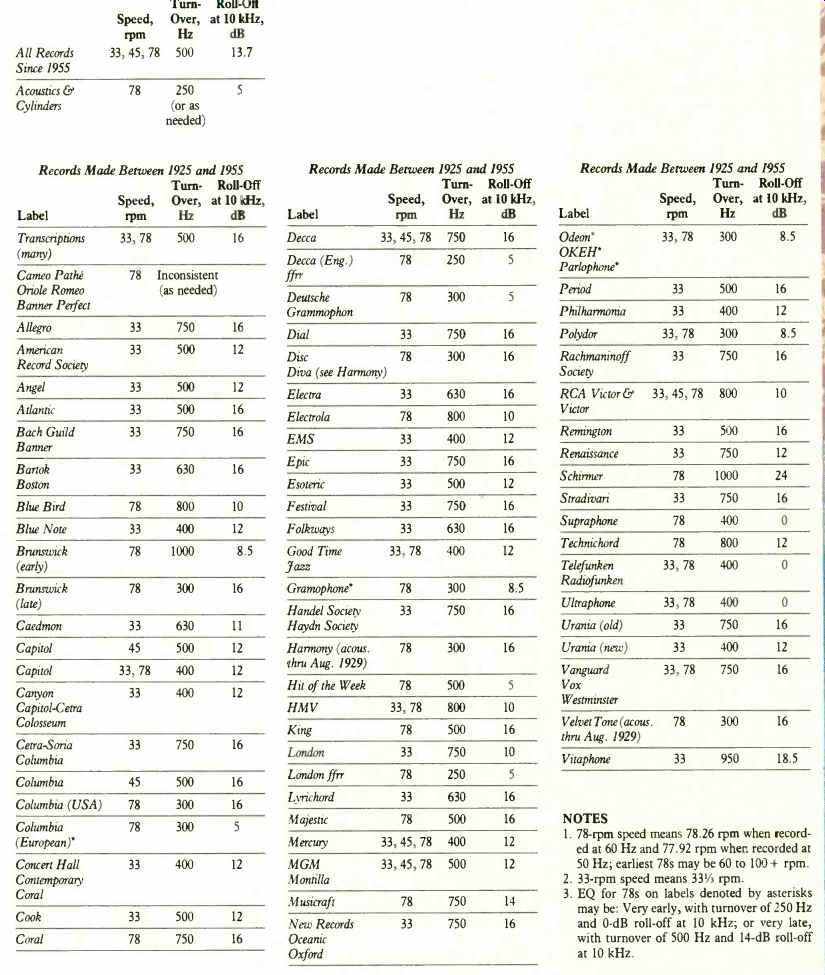
Table II -- Suggested inherent record EQ settings.
NOTES :
1. 78-rpm speed means 78.26 rpm when recorded at 60 Hz and 77.92 rpm when recorded at 50 Hz; earliest 78s may be 60 to 100-t rpm.
2. 33-rpm speed means 33 1/3 rpm.
3. EQ for 78s on labels denoted by asterisks may be: Very early, with turnover of 250 Hz and 0-dB roll-off at 10 kHz; or very late, with turnover of 500 Hz and 14-dB roll-off at 10 kHz.
==========
Acoustic records should be played back with a 250-Hz or higher turnover; otherwise, the bass, which was greatly attenuated by the mechanical equalization of the primitive recording process, will be almost nonexistent. At the lowest frequencies, where rumble may become severe, a high-pass filter should be employed as needed. Additionally, some slight roll-off of the high frequencies might be used, perhaps 5 dB at 10 kHz but rarely more. Some maintained that acoustic discs should be played back with no inherent equalization, since this duplicates the original condition of mechanical recording, a theoretical constant velocity response. If one likes the tinny sound of acoustic recordings acoustically reproduced for nostalgia, this may be okay, but this method ignores the mechanical equalization inherent in the process. Using a 250-Hz turnover with acoustic recordings does not exactly reverse the erratic inherent mechanical equalization. but it does help and offers a starting point for further work. In the field of sonic preservation, as opposed to sonic restoration, an argument can be made for using no inherent electrical equalization (no turnover) on acoustics, but we much prefer 250 Hz or higher with clear documentation as to what was done.
Electrical recordings have never been controversial as regards their need for using playback equalization, but there is still some disagreement as to what specific curves to use on which company's records made at what time.
Based on the published curves, the McIntosh chart, information from record manufacturers, and many years of experience with old recordings. we have developed a list of recommended turnover and roll-off characteristics for playing most old recordings (see Table II). These are a good starting point. but only a starting point. In the earliest days of electric recording. engineers varied inherent equalization so frequently and erratically that the published curves couldn't be relied on as accurate for any specific record. Additionally, records issued at the same time and on the same label can be from different sources and hence have differing inherent EQ. Again, as in all matters related to the reproduction of old recordings, the trained. educated, and experienced ear is the best judge.
In a way, inherent equalization for older recordings has itself become a type of adjustable equalization, since multiple choices have to be made to inversely duplicate the inherent equalization of the original.
NOISE REDUCTION
Noise-reduction systems are of two types-the double-ended or closed type (sometimes called encode/decode), where something is done during recording and undone during playback. and the much more difficult single-ended or open type, where only the playback can be affected. Most commercially available systems of the single-ended type, which are essential for 78s, are of little use in sonic restoration work. The most notable exception is the Packburn Model 323A noise suppressor (see Fig. 4). The Packburn has three noise-reduction systems designed to handle the different types of noise found on historical recordings.
The first processor, called Switcher, selects the quieter of the two record groove walls when there is a significant difference in noise. It does this at a rate down to the resolving power of the stylus, but when operated below a user-selected threshold, the Switcher will produce an A + B output. The second processor, Blanker, eliminates most clicks and pops (impulse noise) by cupping off noise spikes down to 300171z. There is a noise problem common on 78s such as "Banner" Columbia acoustics and HMV electrics. On many, the clicks and pops are so frequent that they overlap each other,. causing a particularly obnoxious frying type of noise often .called "crackle." In effect. crackle greatly raises the hiss or noise floor. The Packburn Blanker is astonishing in eliminating this type of noise, and we know of nothing else that does the job so well. Finally, there is the Continuous Noise Suppressor, a gated high-frequency filter that can pass transients without the pumping so common and obnoxious on other systems. Of course. the Packburn, like any other signal processor, can be misadjusted to give poor results. hut it is an extraordinarily valuable tool when used properly.
For straight hiss reduction, the Dynafex Audio Noise Reduction System is hard to beat and even a bit more effective than the Packburn's Continuous Noise Suppressor. It's a bit tricky to adjust and, unlike the Packburn, it colors the bass sound slightly, but this can be reduced with parametrics. We have upgraded dual op-amps U-3, 4, 5, and 6 to Analog Devices AD-712s; this seems to just about eliminate the coloration. We have also used the AD-712 and AD-713, dual and quad op-amps, respectively, wherever we could in our audio system and are very pleased with the sonic results. The use of downward expansion to reduce noise is great in theory, but vie would use only the mono Dynafex Model DX-1, as it has an extended range that enables great subtlety of operation, whereas the stereo Dynafex and other systems are more abrupt and the results can be audible.
John S. Allen has suggested the synchronous playback of multiple copies of records for improved signal-to-noise ratio. This would have to be done using SMPTE time codes and wouldn't be possible in the many cases where duplicate copies aren't available. Combining Allen's idea with the Packburn's Switcher is a possibility that needs investigation.
Digital reduction of noise via Sonic Solutions' NoNoise process has been much in the news lately. Their impulse-noise (click and pop) suppression may be marginally better than the Packburn's Blanker, but it . extremely expensive and unavailable for "real time" operation as it takes about eight minutes to process one minute of music.
Sonic Solutions' Work Station includes very elaborate digit , editing and processing capabilities, and represents potentially a great advance in restoration work, but i’ts full potential still seems a long way off. Reduction of hiss by the NoNoise process is very irregular, based on our analysis of CDs where the process was used, and often relatively dull and lifeless compared to the original 78s. However, this may be a matter of the choices made by processing operators or recording company clients rather than any defect in the technology itself. Listening critically to the before-and-after demo tape of the NoNoise process convinces us that the unprocessed version is more natural sounding. NoNoise, while reducing noise digitally, does seem to add to the final version the worst qualities of digital sound, qualities which recent digital work has been getting away from.
In England, the National Sound Archive, jointly with the Department of Engineering at Cambridge University, has developed Computer Enhanced Digital Audio Restoration (CEDAR). Both CEDAR and NoNoise seem effective on click and pop reduction but very questionable on hiss reduction.
Without doubt, the future of noise reduction and restoration via digital techniques is wide open. The cost will come down, but the people doing the work will still need skill, patience, extensive experience with historical recordings, enough time to do the job right, and a sense of integrity to the authenticity of the original performance as well as a large dose of common sense! We have observed that since the demise of the 78, transfers and restorations done by collectors and restorers, perhaps with little in the way of elaborate equipment, can, on occasion, far surpass the products of the major recording companies. This shouldn't necessarily be so. It may be partly explained by the remove noise quickly at any cost approach of some and the patient, tender loving care of others. There is some excellent work being done today, but when you go to the music store and buy a restoration, be it analog or digital, on LP, CD, or cassette, "you pays your money and takes your chances."
SONIC REBALANCING
Preliminary sound rebalancing to compensate for recording deficiencies can be done with a half- or third-octave multi-graphic equalizer. Weak areas in the treble and bass can be boosted, and broad areas of unpleasant resonance can be minimized. It is widely believed that the frequency response on acoustic recordings is about 150 Hz to 4 kHz, but a bit of experimenting with a third-octave multi-graphic will show that the frequency response on many is much wider. If the record is in good condition and has not had the higher frequencies literally scraped off by antique playback heads, which operated at weights up to and over 1 pound, then response up to 7 or 8 kHz may be found. While these frequencies are weak and need boosting, it can be done successfully since the shellac surface noise is worst about 3 kHz and tends to decrease at higher frequencies. Selective frequency boosting, combined with noise reduction and other techniques, can result in a lifelike vitality that can only be believed when heard. After all, these acoustic 78s, as well as most of the later electric 78s, were "direct-cut" discs, and despite their many obvious limitations, a sense of vital realism is possible when they are properly reproduced.
STUDIO BALANCE AND HEARING
The restorer's overall audio system should be of very high quality and must incorporate both room and speaker equalization for flat response.
Without it, any rebalancing work done will have no meaningful reference, and judgments or comparisons made will incorporate the room and speaker imbalances. Flat response is the sine qua non of any sound work and, while not correcting subtle differences in audio playback systems, at least can give a fairly good reference standard. Additionally, the room and speaker equalization must be separate and distinct from all other equalization used in sonic restoration work.
Of great importance is the hearing of the sonic restorer, which must be good or correctable. Critical sound work is impossible if one has a cold or other problem that degrades the hearing. It is possible, in some cases, to compensate for hearing deficiencies by introducing a correction factor into the room and speaker equalization tailored for a specific individual, but if the hearing problem is tinnitus or distortion, a correction factor is not possible. Excessive sound levels should always be avoided. Indeed, the Number One injury in the United States today is traumatic hearing loss. Parametrics are especially dangerous, as incredible sound levels in very narrow frequency bands may not seem nearly as loud as they actually are. Many in the recording industry, particularly sound engineers and musicians, have damaged hearing from excessive sound levels. A good rule of thumb is that whenever you have to shout to be heard, leave immediately, for you are at risk of permanent hearing damage. Depending on the type of loss, hearing aids may be a big help, and reluctance by sound experts to be seen wearing them is regrettable if understandable.
Unfortunately, by the time most people become aware of any hearing problem, the loss is permanent.
We'll discuss advanced considerations in the next part of this article. A The records shown are from the collection of Michael R. Lane and Donald H. Holmes, who run a restoration service, put out auction lists of historical records, and offer specialty equipment for historical record reproduction. Lane Audio & Records is located at 1782 Manor Dr., Vista, Cal. 92084; the phone number is (619) 945-7017.
= = = =
Next: Sonic Restoration of Historical Recordings--Part 2 (Jul. 1991)
Also see: Buried Treasure--Sony Classical's Masterworks Heritage Reissue Series (March 1997)